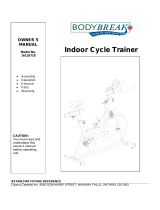a) Ten seconds are long enough for accuracy, (b) The pulse count is to approximate your BPM rate at
the time you are exercising. Since heart rate slows as you recover, a longer count isn’t as accurate.
The target is not a magic number, but a general guide. If you’re above average fitness, you may work
quite comfortably a little above that suggested for your age group.
The following table is a guide to those who are keeping fit. Here we are working at about 80% of
maximum
.
Age 253035404550556065
Target heart Rate
10SecondCount262625242322222120
Beats per Minute 156 156 150 144 138 132 132 126 120
Don’t push yourself too hard to reach the figures on this table. It can be very uncomfortable if you
overdo it. Let it happen naturally as you work through your program. Remember, the target is a guide,
not a rule, a little above or below is just fine.
Two final comments:(1) don’t be concerned with day to day variations in your pulse rate, being under
pressure or not enough sleep can affect it;(2) your pulse rate is a guide, don’t become a slave to it.
Muscle Soreness
For the first week or so, this may be the only indication you have that you are on an exercise program.
This, of course, does depend on your overall fitness level. A confirmation that you a re on the correct
program is a very slight soreness in most major muscle groups. This is quite normal and will disappear
in a matter of days. If you experience major discomfort, you may be on a program that is too
advanced or you have increased your program too rapidly.
If you experience PAIN during or after exercise, your body is telling you something. Stop
exercising
and consult your doctor.
What to Wear
Wear clothing that will not restrict your movement in any way while exercising. Clothes should be light
enough to allow the body to cool. Excessive clothing that causes you to perspire more than you
normally would while exercising, gives you no advantage. The extra weight you lose is body fluid and
will be replaced with the next glass of water you drink. It is advisable to wear a pair of gym or running
shoes or “sneakers”.
Breathing during Exercise
Do not hold your breath while exercising. Breathe normally as much as possible. Remember,
breathing involves the intake and distribution of oxygen, which feeds the working muscles.
Rest periods
Once you start your e xercise program, you should continue through to the end. Do not break off
halfway through and then restart at the same place later on without going through the warm-up stage
again. The rest period required between strength training exercises may vary from person to person.
This will depend mostly on your level of fitness and the program you have chosen. Rest between
exercises by all means, but do not allow this to exceed two minutes. Most people manage with half
minute to one minute rest periods





















